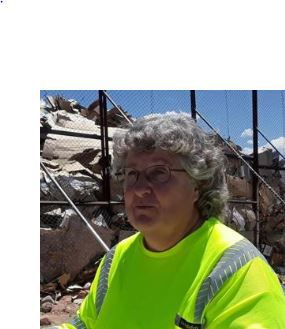With the new reduction in services at the community recycling center, several folks are asking what is going to happen to recycling both here and worldwide.
Let’s reflect first on the history of recycling. Ancient Rome is reported to have melted old bronze coins to make statues. In the 19th century, peddlers in the United States would go door-to-door selling goods and purchasing metal for recycling.
In 1919 Chicago, over 1,800 scrap material dealers were listed (granted, some of them were criminals hiding theft of materials). During the 1930s Great Depression, and in the old West, flour sacks were made into clothing or other useful cloth items. The economic boom after World War II led to a change in consumer culture resulting in more trash. We became a throw-away society.
We lost the economic incentive to recycle many things.
By the time Earth Day formed in 1970, the reason for recycling changed. It was no longer an economic motive, rather a desire to protect the environment by better handling trash. Today, we still have a throw-away mentality. Instead of choosing durability and economic recyclability, we demand convenience. But, there is a desire to reduce waste generation, and more people realize that some material will continue to have great value for recycling. (Especially materials that can be recycled indefinitely, and when recycled material is cheaper than virgin feedstock.)
Today, China (long the world’s premier user of recycled materials) is pushing back. Because the world refused to properly separate their materials to provide a clean feedstock, China is rejecting it. This should be not only a wake-up call for our society to make wise purchase decisions, but a chance for individuals and companies to take responsibility for their “waste” materials.
Consider a person who has been injured and has to endure physical therapy in order to recover. Recycling’s “injury” is the high level of contamination in materials pulled from the waste stream. The response involves therapy — learning how to sort to provide clean feedstock. This involves “nasty work” like cleaning out food or garbage from containers. Just as an accident victim learns to walk through physical therapy, so too the recycling industry must work hard to control its actions and relearn the basics. We must learn to do without some things, however convenient. We must adapt, recognizing the needs and then addressing them. It will always be a challenge.
First, we need to decide what and how we buy things. Do we need bottled water, or do we use refillable canteens or water bottles? Do we need to replace our computers every year just to have the latest and greatest? Perhaps we should demand that the software developers take into account current hardware and make software than can run on older equipment.
We need to meet standards and follow instructions when we recycle materials, either curbside or at the recycling center. If a certain item cannot be recycled locally, then decide whether it makes sense to drive elsewhere to recycle it, or throw it away. We must break the bad habit of leaving the material for someone else to clean up.
We must be willing to pay for packaging and its handling. Yes, we’ve considered deposit bills and plastic bag bans, but a bigger challenge is consumers’ demanding more from their manufacturers for responsible production of material, such as developing buyback programs. We need to expand our horizon to think “pay as you go,” whether for trash or recycling, but it must be supported by both improved quality and larger quantities.
The biggest challenge for the future of recycling is to realize and accept that it is time to grow, mature and change our thoughts on recycling. Some materials can be used over and over again without degrading, such as metals. So, we should personally seek to purchase items that can be recycled indefinitely. Other materials can only be recycled once or twice before they can no longer be recycled (such as most plastics and some paper). We should carefully decide whether or not to buy the item, recognizing it might not be recyclable. In some instances, we are not given a choice, as laws and regulations require no second use of materials, such as food packaging, per the U.S. Food and Drug Administration.
Ultimately, we must recognize that zero waste is an aspiration, but unattainable as a goal. Make goals that are attainable, even able to be exceeded. Consider monetary value as well as the environmental impacts — whether through reduction of greenhouse gas emissions, or through reduced energy consumption. Let us each make the choices of purchase, consumption and waste generation.
Recycling is not dead, nor is it dying, but it has been injured and it will take time to recover.
Over time, we will see the quantities and types of materials recycled change and increase. We will pay for recycling as we do for disposal. In the past, we could go to the local town dump at no charge, but now, we pay for landfilling. To keep recycling alive, we need to take our physical therapy seriously, exercise our creative juices and pay the piper or we will not recover from the injury. The choice is ours.
Deborah Barton has been involved in solid waste and recycling since 1991 and maintains national certifications for landfill, compost and recycling management. She has been with the Solid Waste Special Service District in Grand County since June 2015.
“We must be willing to pay for packaging and its handling. Yes, we’ve considered deposit bills and plastic bag bans, but a bigger challenge is consumers demanding more from their manufacturers for responsible production of material, such as developing buyback programs.”



